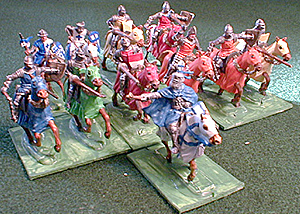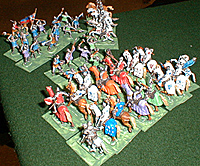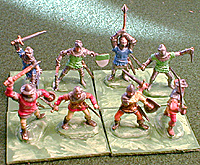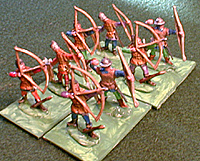 Historical Background: In 1415 Henry V’s invasion
of France wasn’t going well. His exhausted army desperately
needed to get to the safety of Calais if they were to survive.
The French were determined to prevent their escape. A large
French army intercepted the English and forced a battle. Henry
deployed his army so that heavy woods would protect both of his
flanks, forcing the French to attack across a narrow front, negating
much of their manpower advantage. To make matters worse for the
French heavy rains had reduced the battlefield to a muddy quagmire.
As the ill-disciplined French advanced through the mud the deadly
English archers shot them to pieces. The French found it next
to impossible to close with the English and their heavy armor
turned into a handicap. Many high-ranking French nobles were
killed or captured by the English, and King Henry lived to fight
another day.
Historical Background: In 1415 Henry V’s invasion
of France wasn’t going well. His exhausted army desperately
needed to get to the safety of Calais if they were to survive.
The French were determined to prevent their escape. A large
French army intercepted the English and forced a battle. Henry
deployed his army so that heavy woods would protect both of his
flanks, forcing the French to attack across a narrow front, negating
much of their manpower advantage. To make matters worse for the
French heavy rains had reduced the battlefield to a muddy quagmire.
As the ill-disciplined French advanced through the mud the deadly
English archers shot them to pieces. The French found it next
to impossible to close with the English and their heavy armor
turned into a handicap. Many high-ranking French nobles were
killed or captured by the English, and King Henry lived to fight
another day.
Battle 1: As the battle began the Duke of Orleans led a wild cavalry charge against the archers on the English left. He was confident that his knights would be able to scatter the archers with ease. Instead his men were buried under an avalanche of arrows and wiped out. The French were stunned. The attack wavered as the Duke of Alencon lost his nerve and began to withdrawal. The French were close to routing off the battlefield without striking a single blow. The English archers took full advantage of their opponent’s confusion and began picking apart the French front line units.
Charles D’Albret, the Constable of France, rallied the French for an attack on the English right. This time they advanced in good order and, despite heavy loses, managed to reach the English lines. The knights waded into the English archers with a vengeance, forcing the English to send in their reserves to stop the onslaught. Count Dammartin led a charge against the center that broke the English lines, forcing King Harry into the melee on the English right.
 The heavy casualties
had sapped the French strength, and the English fought valiantly.
The attack lost momentum, and the French began to melt away.
A small group of French mounted knights managed to get to King
Henry, but the King’s luck held and he survived their assault.
A review of the carnage showed that this battle closely matched
the historical outcome – a decisive English victory.
The heavy casualties
had sapped the French strength, and the English fought valiantly.
The attack lost momentum, and the French began to melt away.
A small group of French mounted knights managed to get to King
Henry, but the King’s luck held and he survived their assault.
A review of the carnage showed that this battle closely matched
the historical outcome – a decisive English victory.
Battle 2: The French generals in this battle had an excellent
plan. Swallowing their pride, the French noble cavalry allowed
the infantry to lead the attack. The French advanced steadily
all along their front, in perfect order. The English archers
cut large gaps in the French lines, but the attack didn’t
falter. The English watched with growing concern as the French
slogged forward through the mud with deadly intent.
Charles D’Albret and Count Dammartin gathered a large mass of cavalry on the French left, with infantry screening them from the frustrated archers. King Harry, seeing the danger, shifted his reserves to meet the threat. The feeble remnants of the French front line hit the English archers and were scattered. Then, with a cheer, the virtually untouched second line thundered into the archers. The cavalry recklessly rode past the stakes to get at the hated English archers. The Duke of York tried to stem the tide but was killed. The French, led by the Duke of Alencon, broke the English center. The English retreated into two groups clustered around King Harry and the Duke of Gloucester on the right, and Lord Camoys on the left.
Lord Camoys and his men were hopelessly outnumbered and surrounded. The French demanded that he surrender. He defiantly shouted “For King Harry” and charged the startled French knights. He was eventually overwhelmed. Henry and Gloucester weren’t faring much better. The French army was exhausted, and close to breaking. But they knew that all would be for naught if they couldn’t kill or capture the King. A final charge, led by Charles D’Albret, the Count of Marle, and the Duke of Alencon fought their way to King Henry and beat him to his knees. The shattered French army headed for home with Henry V, King of England, as their prisoner.
Rules
The Miniatures:
The figures used were 1/72-scale plastics mounted two per stand, a mix from several sets. Most of the figures were from Revell's English Men at Arms and French Knights. Italeri also has a box of French Hundred Years War soldiers. It's difficult to get enough longbow men for this battle. You may have to substitute, or mount them one figure per stand. All units were six stands in size - 3 stands in the front rank, three in the rear rank.
|
English: Left: Center: Right: |
French: Front Line: Second Line: Third Line: |
The Board:
A 5 X 5 foot table was used. The terrain is flat and clear of obstacles.
 Deployment:
Deployment:
The English deploy at one table end. The French deploy at the opposite end and must be at least 24" from the English. They should be in three lines. The mounted knights untis in the first line should be on the left and right wings.
Sequence of Play
-
1. French Move
2. French Shoot
3. English Move
4. English Shoot
5. Charge into Melee
6. Melee
Movement:
All infanry move and charge 6", cavalry move and charge 12". The French had a terrible time moving across the muddy battlefield, but playtesting showed that there was no need to reduce their movement.
Shooting:
English longow units can fire up to 24". French crossbow units have a maximum range of 12" Roll 1D6 for each stand in range. The shooting table shows the number needed for a hit. Every hit removes one enemy stand. If any part of a unit is in range the entire unit may fire. Units that are engaged in melee may not fire, and may not be targeted.
Charge into Melee:
Both sides may charge into melee. If it makes a difference the French make their charges first. This is the only way to get into hand-to-hand fighting. Foot units may charge up to 6", cavalry may charge 12". Units may only charge if they can reach an enemy unit.
Melee:
Each side rolls 1D6 for each stand in the fight. The Close Combat table shows the number needed to score hits. Remove one enemy stand for every hit. Both sides roll simultaneously. If both units still have stands left they remain engaged and fight again next turn.
 Stakes:
Stakes:
The English longbow men used sharpened stakes to break up the French cavalry charges. All longbow units have stakes protecting them at the start of the battle. If they ever move the lost the benefit of having stakes for the remainder of the battle. Any mounted knight unit attacking a longbow unit with stakes from the front rolls one less die in melee.
Last Stand:
If a unit is reduced to one stand this last stand is removed immediately.
Generals:
Generals may not be targeted individually if they are attached to a unit. If they are attached to a unit they count as an extra stand in melee (but not shooting). If the unit they are attached to loses stands in melee roll 1D6. If the roll is a 6 then the General is eliminated. If the general is charged while alone he may be eliminated just like any other stand.
Victory Conditions:
The French win if they eliminate King Henry. The English win if they prevent this from happening.
Resources:
A search of the Internet, and Magweb.com (www.magweb.com) turned up some useful resources for wargaming Agincourt.
- "Agincourt as a DBA Game," by Russ Lockwood, The Courier #81
- "The Battle of Agincourt, a BBDBA Scenario," by George Goncalves Gouveia, Fanaticus (http://fanaticus.org/) website
- "The Battle of Agincourt, a DBA Scenario," author unknown, Fanaticus (http://fanaticus.org/) website
- "Battle of Agincourt," by Russ Lockwood, Saga # 82
- "Agincourt, a Very Uncommon Battle," by Rich Knapton, Saga # 83 - 84
|
|
|
Back to Table of Contents -- Junior General Report #1
Back to Junior General Report List of Issues
Back to MagWeb.com Magazine List
© Copyright 2002 by Matt Fritz.
This article appears in MagWeb.com (Magazine Web) on the Internet World Wide Web. Other articles covering military history and related topics are available at http://www.magweb.com